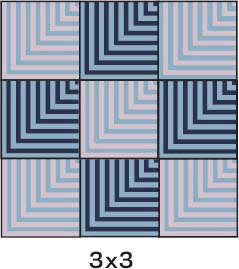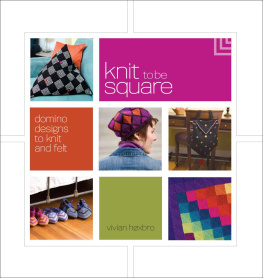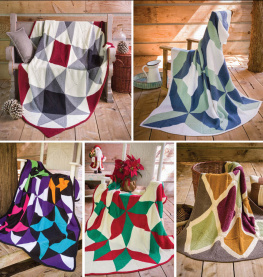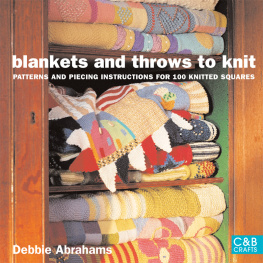Knit to be
Square
Vivian Hxbro

Acknowledgments
Many thanks to:
Else Nielsen
who knitted many of the projects for this book, corrected the instructions, and proofread the manuscript critically. I could not have managed without you!
Kirsten Jensen
for being the friend I share ideas with, for being the friend who gets ideas, for being my untiring friend, and for knitting for me despite a very demanding day job.
Jubbe Netterstrm
for being my wonderful husband for more than twenty-five years, for always comforting me, for keeping my self-confidence in balance, for bearing with me when Im tied to the computer, and when I knit row after row.
Lis Jensen and Helle Srensen
for knitting for me and correcting the instructions.
Chick and Pat Colony
for producing the beautiful yarn that I so enjoy knitting with.
Contents

[Introduction]
There has been such good response to Domino Knitting (Interweave, 2002) that I felt compelled to expand on those techniques and give readers even more ideas for this relaxing, but exciting, type of knitting. You dont need to be an expert knitter to knit domino squaresall you need to know is how to cast on, knit, purl, decrease, and bind off. Best of all, each square involves relatively few stitches and only minimal attention before the unique shapes take hold. But be preparedthis is an addictive form of knitting! One square leads to another, which leads to another, and so on.
I always keep a basket of colorful yarn and a pair of needles close at hand. Whenever the inspiration strikes, I pick up a couple of colors and knit a square. Before I know it, a design comes to life. Some of my designs are based on serendipity and others result from careful planning and development. Either way, I build square upon square to form blocks that become the foundations for all sorts of fascinating projects.
I generally like to knit my squares at a looser gauge than might be suggested by the yarn manufacturer so that I can felt the finished project in the washing machine. Not only does machine felting tighten up the stitches to make a dense fabric, it also hides small mistakes or uneven stitches!
SQUARES
Knitted squares form the foundation for domino projects. A square begins with an odd number of stitches and is shaped by working double decreases on the center three stitches of every other row. The size of a square depends on the number of stitches in the first rowthe more stitches, the larger the square. Most of the squares in this book are worked in garter stitch (every row is knitted), which produces a subtle texture pattern that is particularly well suited for stripes.
BLOCKS
All of the projects in this book begin with blocks, which are composed of squares worked one on top of another to form panels. Panels are worked side by side (always from left to right) to form a block. In general, a block has the same number of squares across the base as along the height. For example, a block may consist of 4 squares (2 squares wide by 2 squares tall), 9 squares (3 squares wide by 3 squares tall), 16 squares (4 squares wide by 4 squares tall), etc. A small block may even consist of a single square.




SPECIAL TECHNIQUES & ABBREVIATIONS
A number of special techniques and abbreviations are used in domino knitting. These are highlighted the first time they occur in each project and are fully explained in the Glossary on .
GAUGE AND MEASURING
The gauge specified for each project is based on the dimensions of a single square. Because squares are always attached to other squares, youll get the most accurate results if you measure your gauge on the center square of a panel of three squares (or better yet, in the center of a block of nine squares). When measuring widths, always measure horizontally between the centers of two squares oriented so that the first row of stitches is along the bottom and the last row is at the top.

FREQUENTLY ASKED QUESTIONS
There are a number of questions that come up every time I teach a domino workshop. Review these questions before you begin to ensure success every step along the way.
What are domino needles?
Domino needles are straight needles that are only about 8" (20 cm) long. They have a knob on one end so that stitches cant fall off and so that the needles wont get stuck in the knitting or your clothing. You can substitute double-pointed needles but be careful not to let the stitches fall off the end. Because they are short, domino needles require less arm movement when turning the work as you knit the squares, and therefore you can knit longer without strain.
How many stitches does a square begin with?
You begin a square with any odd number of stitches. An odd number is needed so that there will be a center stitch, about which double decreases are worked.
Are squares always worked in garter stitch?
No, not necessarily. But because the simple relationship between the number of stitches and rows per inch in garter stitch, its ideal for knitting true squares. You can use other stitch patterns, but the finished piece may not measure the same dimension in width and height (i.e., it may be rectangular instead of square).
How many stitches do I pick up and knit along a square when joining?
To maintain the correct dimensions of a square, you should pick up and knit the same number of stitches that are on each side of the center stitch of the first row. For example, if a square began with 25 stitches, youll want to pick up and knit 12 stitches along each side, and 1 stitch in the center stitch for a total of 25 stitches picked-up (in garter stitch, this translates to 1 stitch for every garter ridge). But many squares begin with the last stitch of the previous square, which counts as the first picked-up stitch.
Why do you always specify the knitted cast-on?
The knitted cast-on tends to be looser than some other methods, and in domino knitting its important that the cast-on stitches have the same tension as the knitted stitches. Also, the knitted method can be used to begin a row of knitting or to add stitches on either side of stitches that are already on the needle.
Whats the importance of edge stitches?
The first stitch of every row (except the first row after casting on) is slipped, and the last stitch is always purled to make tidy edge stitches that are easy to identify when picking up and knitting stitches along the edges of the squares when forming a panel or block. The edge stitches are also nice when used for two-row stripesthere is one edge stitch for each two-row stripeespecially when worked as a twisted selvedge (see Glossary, ).














